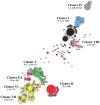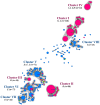Distinct transmission networks of Chlamydia trachomatis in men who have sex with men and heterosexual adults in Amsterdam, The Netherlands
- PMID: 23342025
- PMCID: PMC3547048
- DOI: 10.1371/journal.pone.0053869
Distinct transmission networks of Chlamydia trachomatis in men who have sex with men and heterosexual adults in Amsterdam, The Netherlands
Abstract
Background: Genovar distributions of Chlamydia trachomatis based on ompA typing differ between men who have sex with men (MSM) and heterosexuals. We investigated clonal relationships using a high resolution typing method to characterize C. trachomatis types in these two risk groups.
Methods: C. trachomatis positive samples were collected at the STI outpatient clinic in Amsterdam between 2008 and 2010 and genotyped by multilocus sequence typing. Clusters were assigned using minimum spanning trees and these were combined with epidemiological data of the hosts.
Results: We typed 526 C. trachomatis positive samples: 270 from MSM and 256 from heterosexuals. Eight clusters, containing 10-128 samples were identified of which 4 consisted of samples from MSM (90%-100%), with genovars D, G, J, and L2b. The other 4 clusters consisted mainly of samples from heterosexuals (87%-100%) with genovars D, E, F, I, and J. Genetic diversity was much lower in the MSM clusters than in heterosexual clusters. Significant differences in number of sexual partners and HIV-serostatus were observed for MSM-associated clusters.
Conclusions: C. trachomatis transmission patterns among MSM and heterosexuals were largely distinct. We hypothesize that these differences are due to sexual host behavior, but bacterial factors may play a role as well.
Conflict of interest statement
Figures


References
-
- Bebear C, de Barbeyrac B (2009) Genital Chlamydia trachomatis infections. Clin Microbiol Infect 15: 4–10. - PubMed
-
- Hsu MC, Tsai PY, Chen KT, Li LH, Chiang CC, et al. (2006) Genotyping of Chlamydia trachomatis from clinical specimens in Taiwan. J Med Microbiol 55: 301–8. - PubMed
-
- Mossman D, Beagley KW, Landay AL, Loewenthal M, Ooi C, et al. (2008) Genotyping of urogenital Chlamydia trachomatis in Regional New South Wales, Australia. Sex Transm Dis 35: 614–6. - PubMed
-
- Pedersen LN, Herrmann B, Moller JK (2009) Typing Chlamydia trachomatis: from egg yolk to nanotechnology. FEMS Immunol Med Microbiol 55: 120–30. - PubMed
Publication types
MeSH terms
Substances
LinkOut - more resources
Full Text Sources
Other Literature Sources
Medical

